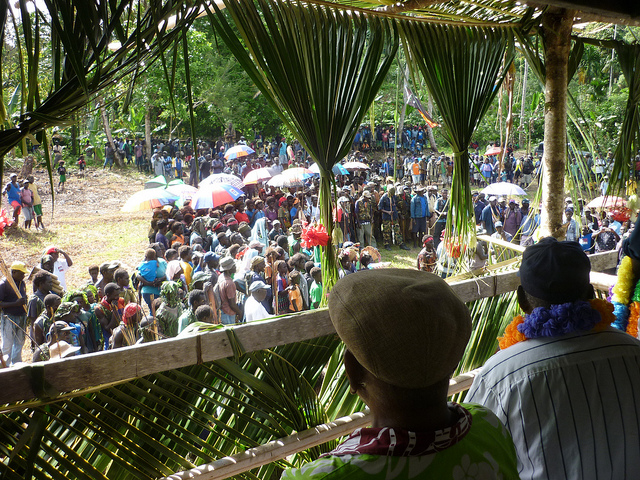In my earlier post I argued that, notwithstanding the strong legal underpinning of the 2001 Bougainville Peace Agreement, it’s possible that Bougainville and Waigani may be on a collision course. What would such a collision mean for Australia?
In the event that a referendum were held and clearly favoured independence with the outcome subsequently ratified by the PNG Parliament—accompanied by an orderly transition—Australia would have little choice but to accept the result. But while this is a possible outcome, it’s by no means the most likely scenario.
Far more likely is a situation in which Papua New Guinea and Bougainville find themselves at odds. Differences could arise in a number of ways but at the more serious end of the range, possibilities include either a refusal by the PNG Parliament to recognise a pro-independence referendum outcome, or a failure by Papua New Guinea to agree to a referendum going ahead at all.
To this, it might be countered that Article XIV of the PNG Constitution includes a range of dispute resolution provisions including through the courts. Yet this ignores the fact that any differences that may arise are far more likely to be political differences than matters of interpretation that are amenable to mediation or judicial resolution.
In either of the disputed situations outlined above Australia would be faced with difficult choices. Of course, Bougainville isn’t Australia’s responsibility, but Australia has a stake in Bougainville’s future, including its relationship with Papua New Guinea. Australia doesn’t have the luxury of not having a view on these questions. In any serious dispute, both sides would look to Australia for support.
Whatever the legal niceties, the PNG government would expect to have the greater claim on Australian support, both on historical grounds and in the light of more recent experience—you-scratch-my-back-and-I’ll-scratch-yours (i.e. Manus) grounds. For their part Bougainvillean groups would point to Australia’s role in acting as midwife to the BPA back in 2000.
In any such scenario a range of Australian interests would be thrown into the balance: Australia’s stake in Papua New Guinea’s long-term security and stability; the state of the bilateral relationship; the risks of renewed violence on Bougainville; the implications of any action (or inaction) on Australia’s part for its broader role in the region.
Many decisions are yet to be taken by the parties themselves, and many variables remain in play. While there are the beginnings of discussion in Bougainville on possible transition scenarios, there’s no requirement for a referendum to be held before 2020, so any breakdown in the process—assuming one does occur—might be years away. So it’s wise not to take the scenario-building too far.
For Australia, however, the key point is this: Downer’s 2000 formula (Australia would ‘accept any settlement negotiated by the parties’) has served successive governments well over the past 15 years when all parties could sincerely declare themselves committed to the BPA. It’s a good formula, and if anything it’s been reinforced by the regular commitment to honouring the BPA included in Ministerial Forum communiques. That said, enough risks are now apparent to suggest that this formula may be reaching its use-by date. Events beyond Australia’s control may require Australia to declare its hand one way or the other.
None of this will be news to Australian officials engaged in PNG policy and, given her personal interest, it’s safe to assume that Julie Bishop understands what’s at stake. That doesn’t make the choices that may be faced any easier.
Much of the above analysis renders the Bougainville issue down to a binary choice: independence or not. Might there be another way of framing the issue? It’s possible that the parties themselves could think of a ‘third way’, even if no such options have been canvassed publicly so far. Even if the PNG and Bougainville governments find themselves seriously at odds on the referendum issue over the course of the next five years, it shouldn’t be assumed that they wouldn’t be able to come up with creative solutions. A worst case scenario isn’t inevitable or even the most likely outcome.
This is where Australian diplomacy could play a role. In 2000, Alexander Downer moved the peace process forward by helping the parties see beyond the immediate binary choices they felt confronted with at the time. The BPA may not have solved the Bougainville question definitively, but it has given the people of Bougainville fifteen years of peace.
It may yet turn out that the key contribution that Australian diplomacy can make is to help the parties see the future as something other than an exclusive yes/no choice.


